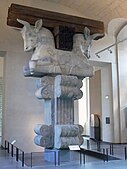Palace of Darius in Susa
کاخ داریوش در شوش | |
Cultural Heritage, Handicrafts and Tourism Organization of Iran | |
| Architecture | |
|---|---|
| Architectural styles | Achaemenid |
The Palace of Darius in Susa was a palace complex that was built at the site of Susa, Iran, during the reign of Darius I over the Achaemenid Empire. The construction was conducted parallel to that of Persepolis. Manpower and raw materials from various parts of the Achaemenid Empire contributed to its construction. It was once destroyed by fire and was partially restored later;[when?] little has remained from the complex, which is today part of an archaeological site.
History
The palace complex was constructed by the
The site of the palace has been greatly damaged during the past seven decades.[2]
Construction
Construction was carried out at Susa parallel to those at
Sources describing Achaemenid-era Susa are rare. The Achaemenid constructions at Susa are mostly known through the royal inscriptions, which are mostly trilingual—in Old Persian, Elamite, and Babylonian. Unlike the massive number of clay tablets found in Persepolis, only few clay tablets have been found in Susa, despite its important political and economic situation.[1]
According to Gene R. Garthwaite, the Susa Palace served as Darius' model for Persepolis. Comparing the palace to that of Pasargadae, the former Achaemenid capital, he argues that Susa even more represented Achaemenid simultaneous rulership, and "what was symbolic was actualized", such that Darius's rule "could command craftsmen and material from the breadth of the empire" to build the monument,[4] as is described in Darius' "charter of foundation" of the palace (or the DSf inscription), which enumerates the workers and the material used:[5]
This palace which I built at Susa, from afar its ornamentation was brought. Downward the earth was dug, until I reached rock in the earth. When the excavation had been made, then rubble was packed down, some 40 cubits in depth, another (part) 20 cubits in depth. On that rubble the palace was constructed.
And that the earth was dug downward, and that the rubble was packed down, and that the
Babylonianpeople -- it did (these tasks).The
Carmania.The gold was brought from
, which was wrought here.The silver and the ebony were brought from Egypt. The ornamentation with which the wall was adorned, that from Ionia was brought. The ivory which was wrought here, was brought from Ethiopia [Nubia] and from Sind and from Arachosia.
The stone columns which were here wrought, a village named Abiradu, in Elam -- from there were brought. The stone-cutters who wrought the stone, those were Ionians and Sardians.
The goldsmiths who wrought the gold, those were
baked brick, those were Babylonians. The men who adorned the wall, those were Medes and Egyptians.Darius the King says: At Susa a very excellent (work) was ordered, a very excellent (work) was (brought to completion). Me may
Darius I, DSf inscription
Gallery
-
Site of the palace
-
Ruins of the Apadana of Susa
-
Reconstruction drawing of the Apadana of the Susa Palace
-
Remains of a Persian column
-
Bull capital from the Apadana of the Susa Palace, Louvre
-
Relief of rosace
-
The Frieze of Archers, glazed siliceous bricks, Louvre
-
Decorative panel with sphinxes
-
Relief of winged lion
-
Statue of Darius, with a quadrilingual inscription at its base
-
Lion-shaped weight
-
Bracelet ornated with a pair of lion heads
-
Winged Aurochs
-
Capital remains of the Apadana palace of Susa located in the museum of Susa
-
Glazed siliceous bricks with a decorative spirals pattern, from palace of Darius the Great at Susa, currently in the Louvre, France.
References
- ^ a b c d "SUSA iii. THE ACHAEMENID PERIOD – Encyclopaedia Iranica". iranicaonline.org. Retrieved 11 July 2017.
- ^ Ed Eduljee. "Susa, Shush. Palace of Darius. Winter Capital". heritageinstitute.com. Retrieved 11 July 2017.
- ^ ISBN 9781848856219.
- ISBN 9781405144001.
- ISBN 9781860646751.
Further reading
- ISBN 9781848856219.


















